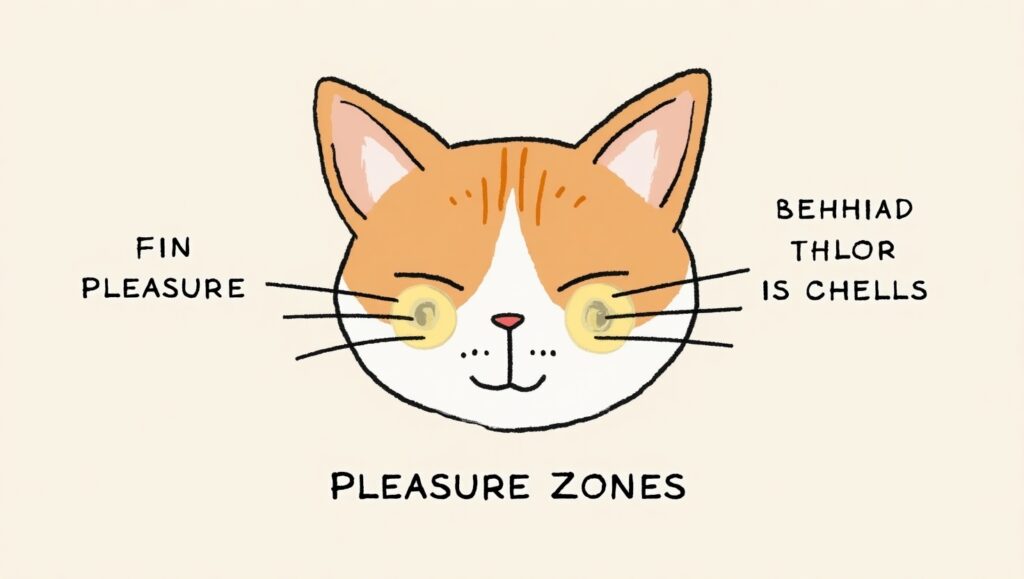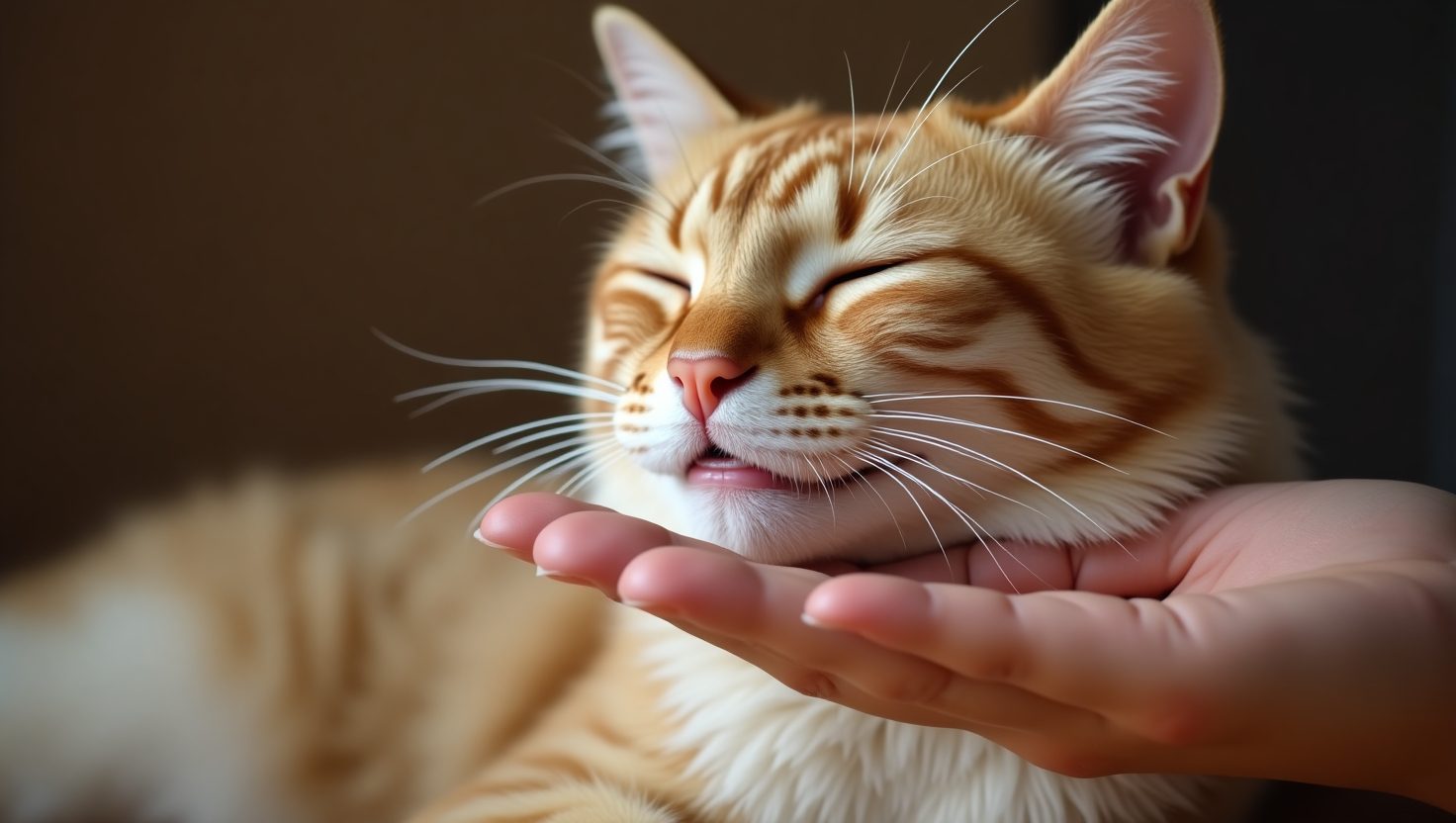Cats like chin scratches because this area is sensitive, filled with nerve endings and scent glands. When you scratch their chin, it mimics the way cats groom each other, which is comforting and helps build a sense of trust. This action triggers a relaxation response and makes them feel loved and cared for.
Cats enjoy these scratches as they can’t easily reach their chin to scratch themselves, so it gives them a pleasurable feeling. It also helps release built-up energy and tension. In addition, the sensation of being scratched in this spot can lead to the release of feel-good hormones, making your cat feel calm and happy.
Chin scratches are not just physical pleasure; they also strengthen the bond between you and your cat, enhancing your relationship. Simply put, it’s a great way to show affection and improve their well-being.

The 9 Reasons Why Cats Like Chin Scratches
Cats are complex creatures, and their love for chin scratches is multifaceted. Here are the key reasons behind this beloved feline behavior:
1. It Feels Good
Just like humans enjoy a good back scratch, cats experience immense pleasure from chin scratches due to the high concentration of nerve endings in that area. The chin, along with the cheeks and base of the ears, are what cat behaviorists often refer to as “pleasure zones.” When stimulated, these areas can trigger profound relaxation and contentment, leading to the familiar purr that signals a happy cat. It’s a pure, unadulterated sensory delight for them.
2. Cats Have Pheromones On Their Face
One of the most significant reasons cats cherish chin rubs is the presence of facial scent glands, specifically located around their lips, chin, temples, and forehead. These glands produce pheromones, chemical signals that cats use to communicate with each other and to mark their territory.
When your cat rubs their chin against you, they are essentially “marking” you with their unique scent, indicating you are part of their safe space or “colony.” Your chin scratches help spread these familiar, comforting scents, reinforcing your bond and their sense of security. It’s a subtle but powerful form of social bonding and communication.
3. It Creates an Intimate Bond
Chin scratches are a powerful tool for strengthening the bond between a cat and their human. This act of gentle interaction fosters trust and affection. When a cat allows you to scratch their sensitive chin area, it signifies that they feel safe and comfortable in your presence. This mutual exchange of affection, often accompanied by purring and leaning into your hand, deepens your relationship, transforming you from a mere provider of food to a trusted companion.
4. Cats Think You’re Grooming Them
In the wild, cats engage in a behavior called allogrooming, where they mutually groom each other, particularly in hard-to-reach areas like the head and neck. This is a crucial social bonding activity among feline groups.
When you scratch your cat’s chin, particularly with your fingers mimicking the strokes of another cat’s tongue, your cat perceives this as a form of allogrooming. This instinctual association reinforces their sense of belonging and care, making the chin scratch not just pleasant but also socially significant.
5. They Want Attention
Sometimes, the reason is simple: your cat wants your attention! Cats are intelligent animals who quickly learn which behaviors yield desirable outcomes. If they associate your chin scratches with positive interaction and affection, they might seek them out when they want to engage with you. A gentle head bunt or a nudge under your hand can be their way of saying, “Hey, I’m here, and I’d love some attention!”
6. They Feel Secure
Chin scratches can evoke feelings of security and comfort. For many cats, this type of gentle interaction replicates the soothing touch they received from their mother during kittenhood. This early association with safety and nurturing makes chin scratches a source of profound comfort, helping them feel secure and relaxed in their environment and with you.
7. It’s Part of Their Instincts
The act of rubbing their faces and chins against objects or individuals is deeply ingrained in a cat’s natural behavior. As mentioned, this is primarily for scent marking their territory and communicating with other cats. By scratching their chin, you’re facilitating this natural behavior, allowing them to deposit their scent and feel a sense of ownership and familiarity over their surroundings and the people within it.
8. They Are Itching
While often a sign of pleasure, sometimes a cat’s desire for chin scratches can stem from a more practical need: an itch! Cats can’t easily scratch their own chins effectively, especially under their jawline.
Your fingers can reach those elusive spots, providing much-needed relief. Occasionally, persistent chin scratching could indicate underlying issues like allergies, fleas, or even feline chin acne, which manifests as blackheads or small scabs. If your cat seems excessively itchy, or you notice irritation, a vet visit is advisable.
Is It Okay to Rub My Cat’s Chin?
Absolutely! For most cats, rubbing their chin is not only okay but highly encouraged. It’s a fantastic way to bond and provide them with comfort and pleasure. However, it’s crucial always to pay attention to your cat’s body language to ensure they are enjoying the interaction. If they show any signs of discomfort, it’s best to stop.
Do All Cats Like Chin Scratches?
No, not all cats like chin scratches.Cats have distinct personalities and tastes, much like people. While a significant majority of cats enjoy chin rubs, some may prefer different types of petting, or perhaps no petting at all from certain individuals. Respecting their individual preferences is key to a positive relationship. Never force affection on a cat.
Is It Typical for a Cat to Refuse Scratches and Pets?
Yes, it is completely normal for some cats not to want pets or scratches. A cat’s comfort with physical touch can be influenced by various factors, including their early socialization, past experiences (positive or negative), genetics, and overall temperament.
Some cats are naturally more aloof or independent, preferring to interact on their terms, which may not include extensive petting. Understanding and accepting your cat’s boundaries is essential for their well-being and maintaining trust.

How Do I Know if My Cat Likes or Dislikes Chin Scratches?
Reading your cat’s body language is paramount.To determine whether they are enjoying your chin scratching, follow these steps.
Signs Your Cat Loves Chin Scratches:
- Purring: The most obvious sign of contentment.
- Head Bunting: Rubbing their head or chin against your hand or body.
- Kneading: Gently pushing their paws into you.
- Leaning In: Pushing their head into your hand for more pressure.
- Relaxed Posture: Loosened body, relaxed tail, often with slow blinks.
- Closed Eyes: Indicates deep relaxation and trust.
- Soft Meows or Trills: Content vocalizations.
Signs Your Cat Dislikes Chin Scratches:
- Tail Swishing or Thumping: Indicates irritation or agitation.
- Flattened Ears or Ears Rotated Sideways: A sign of discomfort or fear.
- Tensed Body: Rigid posture, hunched back.
- Hissing or Growling: Clear warning signs.
- Swatting or Biting: Direct indication to stop.
- Looking Away or Trying to Escape: Desire to disengage.
- Pupil Dilation: Can indicate fear or arousal.
How Often Should I Give My Cat Chin Scratches?
The frequency depends entirely on your cat. Some cats are constant attention-seekers who would happily receive chin scratches all day long, while others prefer shorter, less frequent sessions. The best approach is to follow your cat’s lead.
Offer a chin scratch, observe their reaction, and continue as long as they show signs of enjoyment. Stop when they indicate they’ve had enough. This allows them to feel in control of the interaction, fostering a positive experience.
Is It Okay to Let My Cat Rub Their Chin on Other People?
Yes, it is generally okay to let your cat rub their chin on other people, provided the cat is comfortable and the person is receptive to the interaction. When a cat rubs their chin on someone, they are extending their social circle and marking that person as part of their accepted environment.
This is a positive sign of trust and acceptance from the cat. However, always ensure the person understands how to interact with cats respectfully and doesn’t force interaction if the cat seems hesitant or uncomfortable. Supervise interactions, especially with children or guests unfamiliar with cat behavior.
The Top 8 Easy Steps to Keeping Everyone Safe and Content When Petting Cats
To ensure every interaction is positive and reinforces your bond, consider these petting tips:
- Always Let Them Initiate: Offer a gentle hand and let your cat approach you and rub against your hand first. This gives them control and makes them feel safe.
- Focus on Pleasure Zones: Most cats enjoy scratches around the chin, cheeks, behind the ears, and the base of the tail. These areas are typically safe and pleasurable.
- Avoid No-Go Zones: Generally, avoid prolonged petting on the belly, paws, or tail unless your cat explicitly invites it (which is rare). These are vulnerable areas.
- Watch for Body Language: Pay close attention to their purrs, head bunting, leaning, and relaxed posture. Stop if you see signs of discomfort like tail lashing, flattened ears, or tension.
- Keep it Gentle: Use soft, even strokes.Steer clear of abrupt or rough movements that can shock them.
- Know When to Stop: Cats have limits. If they pull away, stop purring, or show any signs of agitation, respect their wishes and end the petting session.
- Positive Reinforcement: To create powerfully positive connections, pair caressing with compliments or a little treat.
- Wash Your Hands: Especially after handling multiple cats or before preparing food, it’s always a good practice to wash your hands.
